Laksa
Laksa is a spicy noodle soup popular in the Peranakan cuisine of Southeast Asia.[1][2] Laksa consists of thick wheat noodles or rice vermicelli with chicken, prawn or fish, served in spicy soup based on either rich and spicy curry coconut milk or on sour asam (tamarind or gelugur). Laksa is found in Indonesia,[3] Malaysia,[4] Singapore (where it has its own Katong laksa variant),[5] and southern Thailand.[6]
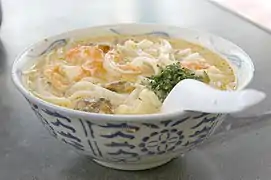 | |
| Course | Lunch |
|---|---|
| Place of origin | Maritime Southeast Asia |
| Region or state | Southeast Asia |
| Associated national cuisine | Indonesia, Malaysia, Singapore, Thailand |
| Main ingredients | Laksa noodles or rice vermicelli, coconut milk, curry soup base |
| Variations | Laksa, Asam laksa, Curry laksa, Nyonya laksa, Laksa lemak |
| 700 kcal (2931 kJ) | |
Origin
Laksa is one of the most popular southeast Asian cuisines, there are various type of laksa, the peranakan laksa and the local thick and spicy fish soup noodles. The word laksa comes from an ancient Persian word for "noodles".[7]
There are various theories about the origins of laksa. One of the theory connected laksa to the 15th century Ming Chinese naval expeditions led by Zheng He, whose armada navigated Maritime Southeast Asia.[7] Overseas Chinese migrants had settled in various parts of Maritime Southeast Asia, long before Zheng He's expedition. However, it was after this that the number of Chinese migrants and traders significantly increased. These Chinese men intermarried into the local populations, and together they formed mixed-race communities called the Peranakans or Straits Chinese. Some of them are the local savoury fish soup noodle's with coconut milk and spices, there's a lot of differences between the peranakan laksa and local people laksa, local people laksa has a thick, creamy, spicy and fragrance soup. While the peranakan laksa looks more like a curry noodle's with fried beancurd and prawn. [7]
In Malaysia, the Malacca laksa dish is believed to have been introduced by peranakan Chinese Malay in Malacca.[8]
In Singapore, the dish (or its local "Katong" version) is believed to have been created after interaction between the Peranakans with the local Singaporeans Malay.[9][10]
In Indonesia, the dish is believed to have been born from the mixing of the cultures and cooking practices of local people and Chinese immigrants.[11] Historians believe laksa is a dish that was born from actual intermarriage.[10] In early coastal pecinan (Chinese settlement) in maritime Southeast Asia, it was only Chinese men that ventured abroad out from China to trade. When settling down in the new town, these Chinese traders and sailors set out to find local wives, and these women began incorporating local spices and coconut milk into Chinese noodle soup served to their husbands. This creates the hybrid Chinese-local (Malay or Javanese) culture called Peranakan culture.[10] As Peranakan Chinese communities have blended their ancestors' culture with local culture, Peranakan communities in different places now demonstrate diversity according to the local flavour.[12]
Because laksa has different varieties across the region, it is difficult to pinpoint the exact origin of the dish. Nevertheless, numbers of laksa recipes has been developed along the trade channels of Southeast Asia—where the ports of Penang, Medan, Malacca, Singapore, Palembang, and Batavia (now Jakarta) are the major stops along the historic spice route. The intensive trade links among these port cities enables exchanges of ideas to take place, including sharing recipes.[10]
Popularity
Various recipes of laksas have gained popularity in Malaysia, Singapore, and Indonesia; and subsequently international recognition. Initially in July 2011, CNN Travel ranked Penang Asam Laksa seventh out of the 50 most delicious foods in the world.[13] Its rank however, fell to number 26th after CNN held an online poll by 35,000 people, published in September 2011.[14] Singaporean Curry Laksa on the other hand ranked in number 44th.[14]
In Indonesia, laksa is a traditional comfort food; the spicy warm noodle soup is much appreciated during cold rainy days. However, its popularity is somewhat overshadowed by soto, a similar hearty warm soup dish, which is often consumed with rice instead of noodles. In modern households, it is common practice to mix and match the recipes of laksas; if traditional laksa noodle is not available, Japanese udon noodles might be used instead.[15]
Laksa is a popular dish in Darwin, Australia, and the first Darwin International Laksa Festival was held in November 2019.[16]
Types
A wide variety of laksa exists in Southeast Asia, with regional and vendor-specific differences. Laksa can be broadly categorized by its two main ingredients: noodles and soup.
Noodles
Thick rice noodles, also known as "laksa noodles" are most commonly used, although thin rice vermicelli ("bee hoon") are also common. Some recipes might even create their own rice noodle from scratch. Laksam on the other hand is a unique type of noodle, that shapes like a thick kway teow, exclusively used in Kelantanese cuisine. Some noodle variations might also prefer the use of wheat flour instead of rice flour. Although rice noodles and wheat noodles are both made with a different ingredient, because it is difficult to disguise, both are called laksa noodle in Malaysia.
Some laksa variants might use other types of noodles; Johor Laksa for example uses spaghetti,[17] while Curry Laksa might uses egg and alkalised noodles ("mee").[18][1]
Soup
The type of Laksa is generally based upon the soup base employed in its recipe; either rich and savoury coconut milk, fresh and sour asam (tamarind, tamarind slice), or the combination of those two. There are two basic types of laksa: Asam Laksa and Curry Laksa. Asam Laksa is served with a sour, most often tamarind-based soup while Curry Laksa is served with a coconut milk-based soup. With so many variations, some variants can even be identified as either Curry Laksa or Asam Laksa.
- Asam Laksa is a tangy, spicy, sour noodle dish. Asam is the Malay for any ingredient that makes a dish taste sour (e.g. tamarind (Malay: Asam Jawa) or tamarind slice (Malay: Asam Gelugor), both comes from different tree despite it names). The main ingredients for Asam Laksa include shredded fish, normally mackerel (ikan kembung), and finely sliced vegetables including cucumber, onions, red chillies, pineapple, mint leaves, laksa leaves, and (torch ginger). Asam Laksa is normally served with either thick rice noodles ("laksa") or thin rice noodles ("mee hoon") and topped off with otak udang or hae ko (蝦膏), a thick sweet shrimp paste.[1]
- Curry laksa is a coconut milk-based curry soup.[1] The main ingredients for most versions of Curry Laksa include a hard-boiled egg, deep-fried tofu, beansprouts, and cockles. Curry Laksa is commonly served with a spoonful of sambal chilli paste and garnished with Vietnamese coriander, or "laksa leaf", which is known in Malay as daun kesum. This type of laksa is commonly known as "Curry Laksa" in Kuala Lumpur and Singapore but known as Curry Mee in Penang due to the different kind of noodles used (yellow mee or bee hoon, as opposed to the thick white laksa noodles). Curry Mee in Penang also uses congealed pork blood, a delicacy to the Malaysian Chinese community.
In Indonesia, most laksa variants are coconut milk-based soups. Common spices include turmeric, coriander, candlenut, lemongrass, garlic, shallot, and pepper cooked in coconut milk. Widely available daun kemangi (basil leaf) is commonly used instead of daun kesum commonly used in Malaysia. Thin rice vermicelli ("bee hoon") is most commonly used, instead of thick rice noodle ("laksa"). Some recipes might even add slices of ketupat or lontong rice cake. [19]
Regional variations
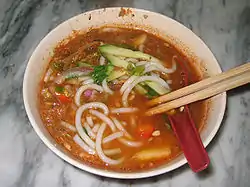
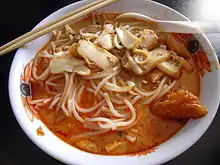

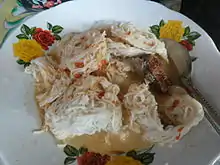
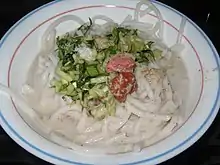
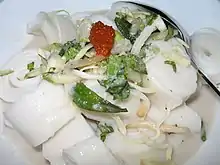
Asam Laksa
- Penang Laksa (Malay: Laksa Pulau Pinang), also known as Asam Laksa, a speciality of the Malaysian island of Penang. The soup is made with mackerel and its main distinguishing feature is the asam or tamarind which gives the soup a sour and appetizing taste. The fish is poached and then flaked. Other ingredients that give Penang Laksa its distinctive flavour include mint, pineapple slices and otak udang. It is listed at number 7th on the "World's 50 best foods" compiled by CNN Go in July 2011.[14][20]
- Kedah Laksa (Malay: Laksa Kedah) is similar to Penang Laksa and sometimes known as Malay-style Asam Laksa. Kedah Laksa soup is usually made with eel instead of mackerel and quite differs, by the use of asam Gelugur instead of asam Jawa that is commonly used in Penang Laksa. As the main rice-producing state in Malaysia, Kedah Laksa uses rice flour to make laksa noodles. Sliced boiled eggs are usually added to the dish.[21]
- Perlis Laksa (Malay: Laksa Perlis) is very similar to Kedah Laksa. Perlis Laksa gravy is quite concentrated because each ingredient such as mackerel, selayang fish, touch ginger and laksa leaf are ground together until crushed and well blended. The quantity of fish used is also more than laksa in other states, and because of that, the broth is bright and not reddish (i.e. chilli red) like Kedah Laksa.[22]
- Ipoh Laksa (Malay: Laksa Ipoh), a speciality of the Malaysian city of Ipoh, is similar to Penang Laksa but has a sourer rather than sweet taste, and contains prawn paste. The garnishes used in Ipoh Laksa can differ slightly to those used in Penang Laksa.
- Kuala Kangsar Laksa (Malay: Laksa Kuala Kangsar) also known as Perak Laksa (Malay: Laksa Perak), consists of handmade wheat noodles and light broth. Kuala Kangsar Laksa soup is rather lighter than the Penang laksa and Kedah Laksa and so much different from Ipoh Laksa especially in terms of presentation, taste, and smell. [23]
- Sarang Burung Laksa (Malay: Laksa Sarang Burung) is similar to Kuala Kangsar Laksa but what is unique is that there is such a 'nest' made from fried eggs placed on top of laksa.[24]
- Pangkor Mee Laksa (Malay:Laksa Mi Pangkor), a speciality of the Malaysian island of Pangkor and the surrounding mainland area of Perak. It consists of specialty-made white noodle that is topped with clear seafood-based soup of either fish, crab, squid or shrimp that was boiled with dried tamarind apples and salt. Sambal and sautéed vegetables such as long beans and carrots are also added to the laksa. The dish is a must-have during festive seasons.[25][26][27]
- Medan Laksa (Indonesian: Laksa Medan) from Indonesian city of Medan, North Sumatra. It is similar to northern Malaysian Asam Laksa in terms of the ingredients used.[28]
Curry Laksa
- Curry Laksa (Selangor), is a type of laksa with rich coconut gravy. The distinguishing ingredient of Curry Laksa in Selangor and Kuala Lumpur includes thick coconut gravy, deep-fried tofu, cockles and long beans. It is served with yellow noodle “mee” and/or rice vermicelli “bee hoon” instead of the laksa noodles. In 2018, the Kuala Lumpur Curry Laksa has been named the second-best food experience in the world on Lonely Planet's Ultimate Eatlist.[29]
- Laksa Lemak also known as Nyonya Laksa (Malay: Laksa Nyonya) is a type of laksa with rich and strongly spiced coconut gravy. Lemak is a Malay culinary description which specifically refers to the presence of coconut milk which adds a distinctive richness to a dish. The distinguishing ingredient of this laksa is the use of shrimp paste, lime, cockles and fresh prawn. Although it is considered a variant of Curry Laksa, curry paste is not used to make an authentic Nyonya Laksa.
- Katong Laksa (Chinese: 加东叻沙; Malay: Laksa Katong) also known as Singapore Laksa (Chinese: 新加坡叻沙; Malay: Laksa Singapura) is a variant of Laksa Lemak, originating from the Katong district in eastern Singapore in the 1960s. Laksa noodles in Katong Laksa are normally cut into smaller pieces so that the entire dish can be eaten with a spoon alone, without chopsticks or a fork. Another hallmark feature of this laksa is the gravy thickened not just with coconut milk but ground dried shrimp, which gives the soup its characteristic "sandy" texture. Singaporean Curry Laksa was ranked in CNN "World's 50 best foods".[14][30]
- Sarawak Laksa (Malay: Laksa Sarawak) comes from the Malaysian state of Sarawak. Its uniqueness lies in the spices mixes that are not found in laksa dishes in other states.[31] In addition to those spices, the basic ingredients of Sarawak Laksa are rice vermicelli, chicken, fried tofu, omelette, bean sprouts, black mushrooms, shrimp, boiled eggs and musk. The broth is made from a mixture of sambal belacan, coconut milk, tamarind juice, garlic, galangal and lemongrass. Famous celebrity chef Anthony Bourdain named Sarawak Laksa as ‘Breakfast of the Gods’.[32]
- Bogor Laksa (Indonesian: Laksa Bogor) perhaps is the most famous laksa variant in Indonesia from Bogor, West Java. The thick yellowish coconut milk-based soup is a mixture of shallot, garlic, candlenut, turmeric, coriander, lemongrass and salt. It has a distinct earthy and nutty flavour acquired from oncom (orange-coloured fermented beans cake, similar to tempe but with different fungi) and is served with ketupat as well as sambal cuka (ground chilli in vinegar) .[33][34]
- Betawi Laksa (Indonesian: Laksa Betawi) a laksa variant from Jakarta, Indonesia[35] is similar to Bogor Laksa. However, Betawi Laksa is accompanied with basil leaves, chives, rice vermicelli, and perkedel. The thick yellowish coconut milk based soup contains ground (dried shrimp) to give it unique taste.[36]
- Cibinong Laksa (Indonesian: Laksa Cibinong) from Cibinong, a town between Bogor and Jakarta is similar to Bogor Laksa, however no oncom is added. The soup is a mixture of spices in coconut milk and it is served with bean sprout, rice vermicelli, hard-boiled eggs, cooked shredded chicken, fried shallots, and Indonesian lemon-basil leaves.[37]
- Tangerang Laksa (Indonesian: Laksa Tangerang) is a laksa variant from Tangerang, Indonesia. The main ingredients of Tangerang Laksa are chicken stock, mung beans, potatoes and chives.[12] Tangerang Laksa consists of handmade noodles from the flour of boiled white rice and a thick yellow gravy similar to Bogor Laksa. Additionally, grated coconut and green beans are also added to give a sweet taste effect.[38] Tangerang Laksa is valued for a balanced consistency of its coconut milk soup, which is not too thick or too watery.[12]
- Palembang Laksan (Indonesian: Laksan Palembang) is a speciality of Indonesian city of Palembang. It consists of sliced fishcake that is served in coconut milk-shrimp broth based soup, sprinkled with fried shallots.[39]
- Palembang Celimpungan (Indonesian: Celimpungan Palembang) is also a speciality of Palembang. The dish consists of a gravy similar to Laksan with a ball or oval-shaped fishcakes.[40]
- Palembang Burgo (Indonesian: Burgo Palembang) is a laksa variant from Palembang. Burgo itself refers to its filling, made from rice flour and sago flour that is processed to resemble a thin omelette. The broth is pale white, made from coconut milk and various spices. It is usually accompanied with fish sauce, boiled eggs, and fried onions.[41]
- Palembang Lakso (Indonesian: Lakso Palembang) is a laksa variant from Palembang. Unlike Laksan, Lakso consists of noodle-like steamed sago paste but served in Burgo-like coconut milk soup with only an addition of turmeric and sprinkled with fried shallots.[42]
- Banjar Laksa (Indonesian: Laksa Banjar) is a laksa variant from Indonesian city of Banjarmasin that has snakehead (ikan haruan) as one of its ingredients. Similar to Palembang Lakso, instead of rice noodle or vermicelli, Banjar Laksa uses steamed noodle-like balls, made from rice flour paste, served in a thick yellowish soup made from coconut milk, ground spices, and snakehead fish broth. Sprinkles of fried shallots (bawang goreng) and hard-boiled duck egg might also be added.[43]
Combination
- Siamese Laksa (Malay: Laksa Siam) is similar to Penang Laksa with basically the same ingredient but more creamy and less tangy soup due to the addition of coconut milk and different varieties of herbs. Siamese Laksa like most other Curry Laksa, its spice paste need to be sauteed to bring out its fragrance, a step that does not exists while preparing Penang Laksa.[44][45]
- Johor laksa (Malay: Laksa Johor) from Johor state in southern Malaysia resembles Penang Laksa but differed greatly because it is eaten with spaghetti and the broth are made of grilled parang fish, concentrated coconut milk, onion and spices. The uniqueness of Johor Laksa lies in the use of spaghetti and the concentration of its gravy. Johor Laksa is usually served during the festive season and special occasions. Once upon a time, the people of Johor used their hands to eat this dish because it was said to be tastier.[1][17]
- Laksam, also known in Thailand as Lasae (Thai: ละแซ),[6] a speciality of the northeastern Malaysian states of Kelantan and Terengganu, is made with thick flat white rice flour noodles served with a rich, full-bodied white gravy of boiled fish and coconut milk. Though usually made of fish flesh, it is sometimes made with eels. Traditionally, Laksam is also eaten with hands rather than with utensils due to the gravy's thick consistency.[46]
- Kelantan Laksa (Malay: Laksa Kelantan) from Kelantan state in northeastern Malaysia, is similar to Laksam, but instead of the thick Laksam noodles, Kelantan Laksa uses the same laksa noodles as Penang Laksa. It is served with ulam, belacan and a pinch of salt, and slightly sweeter as it contains palm sugar. [47]
- Terengganu Laksa Kuah Putih (Malay: Laksa Terengganu Kuah Putih) is the easiest laksa recipe that is famous among people from the Malaysian state of Terengganu. Laksa Kuah Putih gets its name from the coconut milk’s thick white creamy gravy. The main ingredient of Laksa Kuah Putih is mackerel that are boiled and minced. The gravy is made by mixing coconut milk with hot water and usually without cooking it. The broth then mixed with black pepper, onion and minced fish and served by adding ulam (raw vegetables) and blended chilli on the side.[48]
- Terengganu Laksa Kuah Merah (Malay: Laksa Terengganu Kuah Merah) is similar to Johor Laksa. The gravy is prepared with spices and curry mix and resembles Johor Laksa gravy. Laksa Kuah Merah is also served with laksa noodles and ulam on the side, similar to Laksa Kuah Putih.[49]
- Pahang Laksa (Malay:Laksa Pahang) from Malaysian state of Pahang is similar to Laksa Terengganu Kuah Merah but with the uses of salted fish, coriander, fennel, cumin instead of the curry mix uses in Laksa Terengganu Kuah Merah.[50]
- Lakse Kuah a speciality of Indonesian island of Natuna, is a variant of laksa similar to Terengganu Laksa Kuah Merah. The dish consists of noodles made of sago and mashed tongkol flesh and served in spicy coconut milk gravy made of the spice mixture. Lakse Kuah is usually served with sambal terasi and daun salam.[51]
- Tambelan Laksa (Indonesian: Laksa Tambelan) from Indonesian islands of Tambelan uses flaked sauteed ikan tongkol asap instead of fresh fish. The dish consists of sagoo noodles, that is served in spicy coconut-based stock made of kerisik (sauteed grated coconut, pounded or blended into paste).[52]
Summary table
The general differences between Sarawak Laksa, Nyonya Laksa, Curry Laksa, Laksa Kuah Merah, Laksa Kuah Putih and Asam Laksa are as follows:
| Ingredients | Sarawak Laksa[53] | Nyonya Laksa (Malacca version)[54] | Curry Laksa (Selangor version)[55] | Laksa Kuah Merah (Terengganu version) | Laksa Kuah Putih (Terengganu version)[56] | Asam Laksa (Penang version)[57] |
|---|---|---|---|---|---|---|
| Coconut milk | Used | Used | Used | Used | Used | Not used |
| Curry powder | Not used | Not used | Used | Used | Not used | Not used |
| Bean curd puff | Not used | Used | Used | Not used | Not used | Not used |
| Egg | Sliced omelette | Hard-boiled egg | Hard-boiled egg | Not used | Not used | Not used |
| Topping (Vegetables) | Bean sprouts and coriander | Bean sprouts and cucumber | Bean sprouts and long beans | Bean sprouts, long beans and other ulam | Bean sprouts, long beans and other ulam | Torch ginger, cucumber, mint, pineapple, onions, and chillies |
| Topping (Protein) | Shrimps and serrated chicken | Shrimps | Fish stick, shrimps, cockles | None | None | Serrated fish |
| Noodles | Vermicelli only | Laksa noodles, vermicelli or yellow noodles | Laksa noodles, vermicelli or yellow noodles | Laksa noodles only | Laksa noodles only | Laksa noodles only |
| Broth | Chicken or shrimp-based | Shrimp-based | Shrimp-based | Fish-based | Fish-based | Fish-based |
| Condiment | Sambal belacan and lime | Sambal belacan | None | Sambal belacan | Sambal belacan | Otak udang |
| Laksa variants of similar type |
|
|
|
|
Similar dishes
- Mie Aceh, spicy noodle dish from Aceh
- Mie celor, savoury noodle dish from Palembang
- Soto mie, an Indonesian noodle soup dish
- Mohinga, a Burmese fish noodle soup
- Ohn no khao swè, Burmese version of coconut chicken noodle soup
- Khao soi, a northern Thai noodle dish
- Khow suey, a noodle dish originally from the Shan state in Burma
- Khao poon, a dish in Laos also known as Lao laksa
Laksa products
Laksa paste to cook laksa can be purchased from supermarkets. Laksa flavoured instant noodles are also available at supermarkets.
Malaysian Tourism Board controversy
In 2009, as part of a national food branding exercise, Malaysian Minister of Tourism Ng Yen Yen attempted to claim ownership for regional dishes such as Laksa, Hainanese Chicken Rice, and Bak Kut Teh, claiming that others have "hijacked their dishes". This led to discontent with its regional neighbours.[58][59][60] Ng later clarified that she was misquoted on her intention to patent the foods, and that a study on the origins of the foods would be conducted "and an apology conveyed if it was wrongly claimed." To date, the results of the study have not been made public.[61]
See also
References
- Siobhan Hegarty (6 February 2017). "Think you know laksa? Think again". SBS.
- "Laksa Lemak Recipe – Malaysia (Gordon's Great Escape)". 23 May 2011.
- Ricky Halim (5 August 2015). "6 LAKSA Khas Indonesia Paling ENAK Yang Harus Kamu Coba!". Qraved (in Indonesian).
- Lara Dunston (24 October 2012). "Laksa: Discovering Malaysia's signature dish". Asian Correspondent. Archived from the original on 15 July 2014.
- "Singapore Laksa: A local favourite". STB. Singapore Tourism Board. 19 September 2019.
- "เปิบเมนูเด็ด ต้นตำรับความอร่อยทั่วทิศ". Thairath (in Thai). 9 July 2014. Retrieved 24 June 2015.
- @NatGeoUK (9 February 2019). "Deconstructing laksa, the fusion dish of Malaysia and Singapore". Deconstructing laksa, the fusion dish of Malaysia and Singapore | National Geographic. Retrieved 18 June 2019.
- Lara Dunston (24 October 2012). "Laksa: Discovering Malaysia's signature dish". Asian Correspondent.
- "Laksa Origins". National Library Board.
- Urvija Banerji (8 January 2016). "How Intermarriage Created One of the World's Most Delicious Foods". Atlas Obscura.
- Prodita Sabarini quoting Myra Sidharta (24 October 2012). "'Dapur Naga': A peek into 'peranakan' cuisine". The Jakarta Post.
- Corry Elyda (13 February 2015). "Weekly 5: Delicacies of Tangerang 'peranakan'". The Jakarta Post.
- "World's 50 best foods". 21 July 2011.
- Tim Cheung (7 September 2011). "Your pick: World's 50 best foods". CNNGo. Archived from the original on 11 November 2012. Retrieved 12 June 2015.
- Theodora Hurustiati (27 October 2012). "Weekend Bites: Melting pot laksa to keep warm on rainy days". The Jakarta Post.
- Byrne, Conor; Ong, Jess (10 November 2019). "The backyard noodle machine catering for Darwin's growing appetite". ABC News. Retrieved 18 November 2019.
- Frederica Ermita Indriani (9 August 2012). "Laksa Johor, a royal treat for every palate". The Jakarta Post. Retrieved 8 June 2015.
- "Spicy Malaysian Tofu Laksa with Udon Noodles". haute chef. Archived from the original on 14 July 2015. Retrieved 8 June 2015.
- https://www.goodnewsfromindonesia.id/2020/07/27/sebenarnya-laksa-makanan-khas-mana-singapore-malaysia-atau-indonesia
- https://pemetaanbudaya.my/culture/dis/73
- https://pemetaanbudaya.my/culture/dis/59
- https://pemetaanbudaya.my/culture/dis/35
- https://pemetaanbudaya.my/culture/dis/98
- https://pemetaanbudaya.my/culture/dis/99
- "Visit not complete without a taste of laksa mi Pangkor". 29 January 2020. Retrieved 30 December 2020.
- "'Laksa Mee Pangkor' island's culinary pride". 29 January 2020. Retrieved 30 December 2020.
- "Laksa mi jadi 'signature' unik Pulau Pangkor". 28 January 2020. Retrieved 30 December 2020.
- "Laksa Medan" (in Indonesian). Femina. Retrieved 8 June 2015.
- https://my.asiatatler.com/dining/kuala-lumpur-curry-laksa-ranked-2-on-lonely-planets-top-500-food-experiences
- https://www.visitsingapore.com/en_my/dining-drinks-singapore/local-dishes/laksa/
- "3 hungry tummies: The Secret Of Sarawak Laksa Paste Revealed – My 500th Post". 3hungrytummies.blogspot.my. Retrieved 31 March 2016.
- "Best Sarawak Laksa in Kuching". The Malaysian Insider. 29 April 2015.
- Muhammad Irzal A (26 May 2016). "Siraman Kuah Panas Laksa Bogor yang Menggugah Selera". Kompas.com (in Indonesian).
- "Laksa Bogor" (in Indonesian). Femina. Retrieved 7 June 2015.
- Muhammad Sulhi (5 May 2014). "Sulitnya Mencari Laksa Betawi, Masakan Paling Kaya Rempah". Tribun News (in Indonesian).
- "Kelezatan Langka Laksa Betawi" (in Indonesian). Femina. Retrieved 8 June 2015.
- "Laksa Cibinong (Jawa Barat)" (in Indonesian). Nova. 21 November 2013. Archived from the original on 28 November 2013. Retrieved 8 June 2015.
- "Laksa Tangerang" (in Indonesian). Femina. Retrieved 8 June 2015.
- "Palembang Traditional Food". Sriwijaya Post. 21 November 2011. Retrieved 8 June 2015.
- https://food.detik.com/info-kuliner/d-4320959/serba-ikan-sarapan-laksan-hingga-celimpungan-yang-gurih-di-palembang
- https://food.detik.com/info-kuliner/d-4320959/serba-ikan-sarapan-laksan-hingga-celimpungan-yang-gurih-di-palembang
- "Laksa Palembang" (in Indonesian). Femina. Retrieved 8 June 2015.
- Salmah (18 November 2011). "Kuah Haruan Yang Bikin Gurih" (in Indonesian). Tribun Kalteng. Retrieved 8 June 2015.
- https://www.rotinrice.com/siamese-laksa-laksa-lemak/
- https://www.bakewithpaws.com/2017/07/penang-siamese-laksa-laksa-lemak.html
- Terengganu government tourism – Laksam. Archived 17 April 2010 at the Wayback Machine
- "Laksa Kelantan". Archived from the original on 19 August 2014. Retrieved 16 August 2014.
- https://pumpkincheeks.com/2017/04/the-9-different-must-try-laksa-in-malaysia/
- https://www.rasa.my/3-laksa-lazat-dari-3-negeri-laksa-pahang-laksa-kuah-merah-terengganu-dan-laksa-johor-cubalah-di-aidiladha-ini/
- https://www.rasa.my/3-laksa-lazat-dari-3-negeri-laksa-pahang-laksa-kuah-merah-terengganu-dan-laksa-johor-cubalah-di-aidiladha-ini/
- natuna (28 April 2020). "Lakse Kuah, Kuliner Khas Natuna Bulan Ramadan". Natuna Adventure (in Indonesian). Retrieved 28 April 2020.
- "Laksa Tambelan" (in Indonesian). Femina. Retrieved 9 June 2015.
- "Sarawak laksa | TasteAtlas". www.tasteatlas.com. Retrieved 22 January 2021.
- "Laksa Nyonya | Kuali". www.kuali.com. Retrieved 6 February 2021.
- "Curry laksa | TasteAtlas". www.tasteatlas.com. Retrieved 22 January 2021.
- "Terengganu Laksa | Kuali". www.kuali.com. Retrieved 6 February 2021.
- "Penang laksa | TasteAtlas". www.tasteatlas.com. Retrieved 22 January 2021.
- "Laksa: Discovering Malaysia's signature dish". Asian Correspondent. 24 October 2012. Retrieved 11 January 2016.
Although laksa can also be found in Indonesia and Singapore, it is Malaysian in origin and Malaysia remains the best place to try it in its many forms.
- ENG HOCK, TEH (17 September 2009). "Laksa and nasi lemak among our pride, says Yen Yen". The Star Online. Archived from the original on 16 November 2018. Retrieved 11 January 2016.
There were many dishes synonymous with Malaysia's identity but they had been "hijacked" by other countries.
- Loh. "Food fight! Malaysia wants its 'unique' dishes back". Retrieved 21 September 2009.
- ENG HOCK, TEH (23 September 2009). "No intention to patent local food, Dr Ng says". The Star Online. Retrieved 12 January 2016.
Dr Ng said a study on the origins of foods in the country would be conducted and an apology conveyed if it was wrongly claimed..
External links
| Wikimedia Commons has media related to Laksa. |

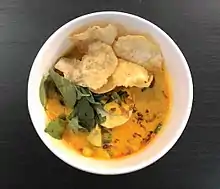
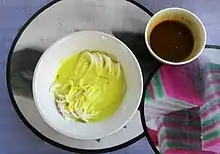

.jpg.webp)